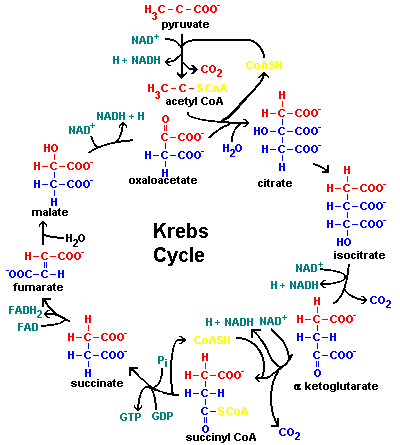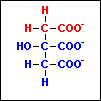|
The citric acid cycle (Kreb's Cycle)
The oxidation of glucose continues in the Krebs cycle. Pyruvate molecules formed during glycolysis diffuse from the cytoplasm into the mitochondrion, but pyruvate itself does not enter the Krebs cycle. First a reaction occurs that removes a carbon atom, releasing it in carbon dioxide. Electrons are transferred to an NADH molecule, storing energy. Coenzyme A, or CoA, joins with the 2-carbon fragment, forming acetyl CoA. One molecule of acetyl CoA enters the Krebs cycle. The 2-carbon fragment of acetyl CoA attaches to the 4-carbon molecule oxaloacetate in the first reaction of the cycle. This forms citrate. In a series of steps, bonds break and reform. Two carbon atoms are released one at a time in molecules of carbon dioxide. Electrons are carried off by molecules of NADH and FADH2. One step produces an ATP molecule. A 4-carbon oxaloacetate molecule is regenerated. Since two acetyl CoA molecules are produced for each glucose molecule broken down, a second acetyl CoA enters the Krebs cycle. The same series of reactions occurs, releasing carbon dioxide and producing more NADH, FADH2, and ATP.
The cell has gained two ATPs that can be used directly. However, most of the energy originally contained in the bonds of glucose is now carried by the NADH and FADH2 molecules. This energy will be banked in ATP in the third stage of cellular respiration.
|

 Above is an animated representation of the Kreb's Cycle. Note that it is aerobic and takes place in the mitochondrial matrix.
Above is an animated representation of the Kreb's Cycle. Note that it is aerobic and takes place in the mitochondrial matrix.
Products of cycle
The yeild from the citric acid cycle (per turn).
2 Carbon dioxide
3 NADH+H+
1 ATP
1 FADH2
|



